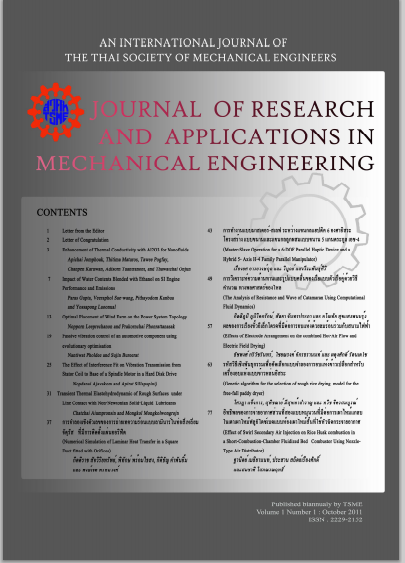Microwave heating on cement-pozzolan pastes: Dielectric permittivity, physical properties and numerical heat transfer characteristics
Main Article Content
Abstract
Cement-pozzolan pastes at a very early stage subjecting to microwave heating were investigated. Microwave at an operating frequency of 2.45 GHz associated with a multi-mode cavity was used. The pastes containing pulverized fuel ash (PFA) or silica fume (SF) were proportioned with a 0.22-water/solid mass ratio (w/s). Test results showed that the temperature increased continuously during microwave heating. Some small fibers appear in the paste but none appear in the microwave-heated PFAcement paste. For the SF-cement paste the SF particles under microwave heating had dispersed. The pastes can be consumed more Ca(OH)2 in the pozzolan reaction to produce more C-S-H. The calculated temperature rise of the paste containing PFA without loss of moisture and steady heat transfer conduction consistently agreed with the proposed mathematical model.
Article Details
This work is licensed under a Creative Commons Attribution-NonCommercial-ShareAlike 4.0 International License.
References
[2] Taylor, H.F.W., (1997). Cement Chemistry, 2nd Edition, Great Britain: Thomas Telford Publishing.
[3] Bhanja S. and Sengupta B. (2003). Modified watercement ratio law for silica fume concretes , Cement and Concrete Research, Volume 33: Issue 3, pp.447-450.
[4] Verbeck, G.J. and Helmuth, R.A. (1969). Structures and Physical Properties of Cement Paste, 5th Int. Congress Cement Chemistry, Tokyo, Japan, pp. 1-44.
[5] Metaxas, A.C. (1991). Microwave heating, Journal of Microwave Power and Electromagnetic Energy, pp.237-247.
[7] Dongxu, L. and Xuequan, W. (1994). A study on the application of vacuum microwave composite dewatering technique in concrete engineering, Cement and Concrete
Research, pp.159-164.
[8] Hutchison. R. G., Chang, J.T., Jennings, H.M., and Brodwin, M.E. (1991). Thermal acceleration of Portland cement mortars with microwave Energy, Cement and Concrete Research, 21, pp. 795-799.
[9] Leung, K.Y.C., and Pheeraphan, T. (1995). Microwave heating of Portland cement concrete: Experimental Results and Feasibility for Practical Applications, Construction and Building Materials, 9, pp. 67-73.
[10] Hutchison, R.G., Chang, J.T., Jennings, H.M., Brodwin, M.E. (1991). Thermal Acceleration of Portland Cement Mortars with Microwave Energy. Cement and Concrete Research, 21, pp. 795–799.
[11] American Society for Testing and Materials, (2008). ASTM C618 Standard Specification for Coal Fly Ash and Raw or Calcined Natural Pozzolan for Use in Concrete, Annual Book of ASTM Standard, Section 4 Construction, Volume 04.02 Concrete and Aggregate.
[12] American Society for Testing and Materials, (2008). ASTM C1240 Standard Specification for Silica Fume Used in Cementitious Mixtures, Annual Book of ASTM
Standard, Section 4 Construction, Volume 04.02 Concrete and Aggregate.
[13] American Society for Testing and Materials, (2008). ASTM C494 Standard Specification for Chemical Admixtures for Concrete, Annual Book of ASTM Standard, Section 4 Construction, Volume 04.02 Concrete and Aggregate.
[14] American Society for Testing and Materials, (2008). ASTM C305 Standard Practice for Mechanical Mixing ofHydraulic Cement Pastes and Mortars, Annual Book of ASTM Standard, Section 4 Construction, Volume 04.01 Concrete, Lime and Gypsum.
[15] Metaxas, A.C., Meredith, R.J. (1998). Industrial Microwave Heating; Peter Peregrinus: Herts, UK, 1998.
[16] COMSOL©Multiphysics, (2010). User’s Guide, COMSOL AB., Stockholm.
[17] Moukwa, M., Brodwin, M., Christo, S., Chang, J. , and Shah, S. P. (1991). The influence of the hydration process upon microwave properties of cements, Cement and Concrete Research, 21, pp. 863-872.


